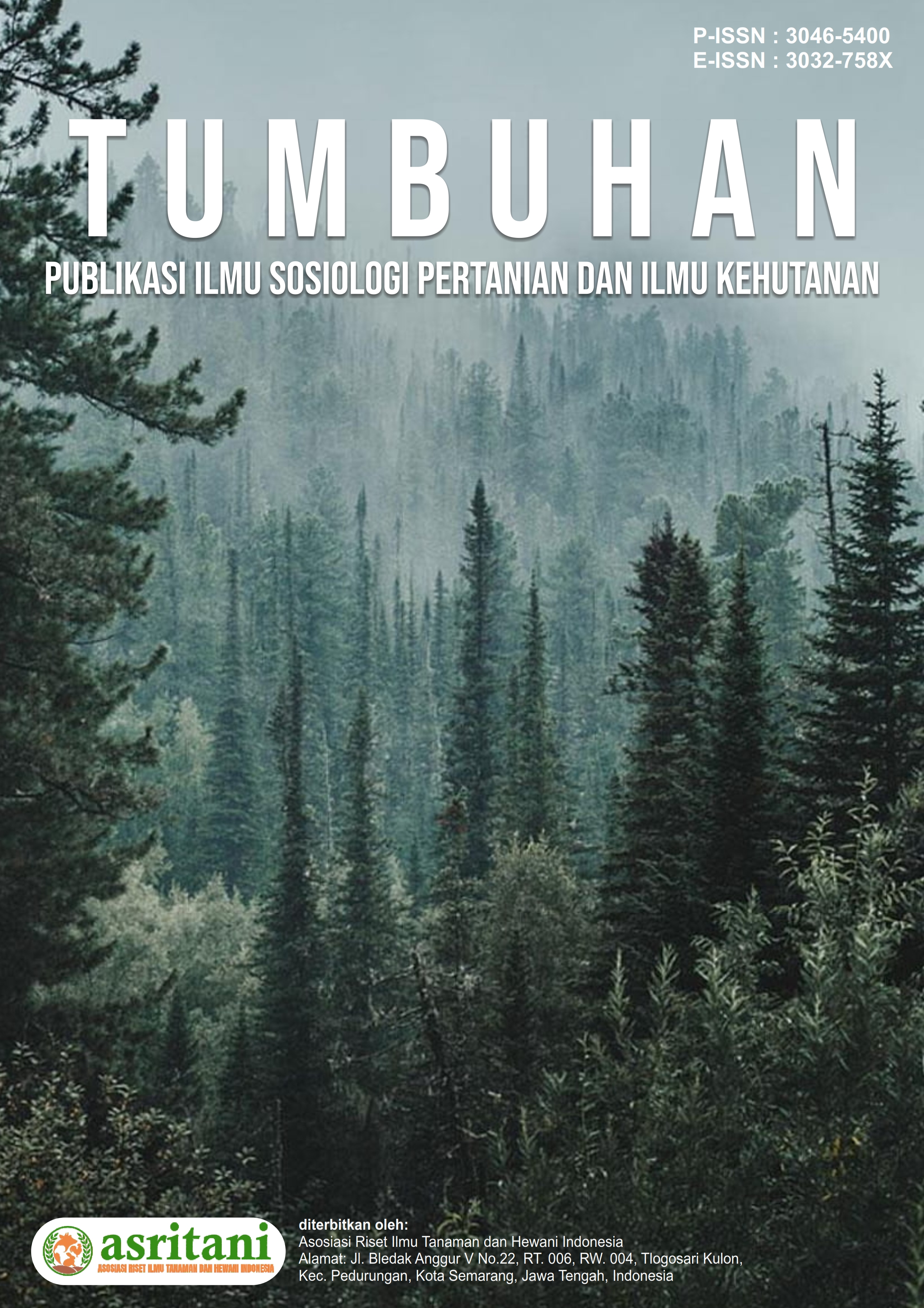The Effect Of Planting Spatial And Eco Enzyme Concentration On The Growth And Production Of Shallots
Allium cepa L.
DOI:
https://doi.org/10.62951/tumbuhan.v2i2.327Keywords:
Eco Enzyme Concentration, Planting Distance, ShallotsAbstract
The research aims to determine red onion plants' growth and production response (Allium cepa L.) on Planting Distance Treatment and Eco enzyme Concentration. This study used a Randomized Block Design (RBD) with two treatment factors. The first factor is the Planting Distance treatment consisting of 3 levels, namely J1 = 15 cm x 15 cm, J2 = 20 cm x 15 cm, and J3 = 25 cm x 15 cm. The second factor is the Eco enzyme Concentration, consisting of 3 levels, namely E1 = 0.8 ml ee / 240 ml water, E2 = 1.6 ml ee / 240 ml water, and E3 = 2.4 ml ee / 240 ml water. The study results showed that the Planting Distance treatment significantly affected root length and tuber diameter per sample. However, they had no significant effect on fresh tuber weight on the growth and production of shallots. The Eco enzyme concentration treatment had no significant effect on all observation treatments. The interaction between Planting Distance and the Eco enzyme concentration had no significant effect on all observation treatments.
References
Arifin, A. S. R., Kristiana, L., & Ramly, M. (2019). PENGARUH URIN SAPI SEBAGAI PUPUK ORGANIK CAIR TERHADAP PERTUMBUHAN DAN HASIL TANAMAN SAWI (Brassica juncea L.). SEMNASDAL (SEMINAR NASIONAL SUMBER DAYA LOKAL), 2(1), 283–289.
Azad, M. O. K., Kjaer, K. H., Adnan, M., Naznin, M. T., Lim, J. D., Sung, I. J., Park, C. H., & Lim, Y. S. (2020). The evaluation of growth performance, photosynthetic capacity, and primary and secondary metabolite content of leaf lettuce grown under limited irradiation of blue and red LED light in an urban plant factory. Agriculture, 10(2), 28.
Beja, H. D. (2020). Pengaruh berbagai jarak tanam terhadap pertumbuhan dan hasil tanaman bawang merah (Allium ascalonicum L.) varietas Bima. Mediagro, 16(2).
Haque, M. A., & Sakimin, S. Z. (2022). Planting arrangement and effects of planting density on tropical fruit crops—A Review. Horticulturae, 8(6), 485.
Heyduk, K., Moreno-Villena, J. J., Gilman, I. S., Christin, P.-A., & Edwards, E. J. (2019). The genetics of convergent evolution: insights from plant photosynthesis. Nature Reviews Genetics, 20(8), 485–493.
Irawan, D., Idwar, I., & Murniati, M. (2017). Pengaruh Pemupukan N, P Dank Terhadap Pertumbuhan Dan Hasil Bawang Merah (Allium Ascalonicum. L) Varietas Bima Brebes Danthailand Di Tanah Ultisol. Riau University.
Lana, W., Wisardja, I. P., & Rusdianta, I. G. M. (2019). PENGARUH DOSIS PUPUK UREA DAN KOMPOSISI MEDIA TANAM TERHADAP PERTUMBUHAN DAN HASIL BAWANG MERAH (ALLIUM ASCALONICUM L): Bahasa Subtitle (Indonesia). Majalah Ilmiah Universitas Tabanan, 16(2), 145–150.
Mahmudi, S., Rianto, H., & Historiawati, H. (2017). Pengaruh Mulsa Plastik Hitam Perak Dan Jarak Tanam Pada Hasil Bawang Merah (Allium Cepa Fa. Ascalonicum, L.) Varietas Biru Lancor. VIGOR: Jurnal Ilmu Pertanian Tropika Dan Subtropika, 2(2), 60–62.
Nasihah, M. (2017). Efek Hujan Asam terhadap Pertum buhan Tanaman. Jurnal EnviScience (Environment Science), 1(1).
Pithaloka, S. A., Sunyoto, S., Kamal, M., & Hidayat, K. F. (2015). Pengaruh kerapatan tanaman terhadap pertumbuhan dan hasil beberapa varietas sorgum (Sorghum bicolor (L.) Moench). Jurnal Agrotek Tropika, 3(1).
Rahnama, A. A., Mohebi, A. H., & Khayat, M. (2017). Study of different fertilization methods on oil palm (Elaeis guineensis) vegetative factors. Journal of Crop Nutrition Science, 3(1), 37–47.
Ramadani, A. H., Rosalina, R., & Ningrum, R. S. (2019). Pemberdayaan Kelompok Tani Dusun Puhrejo dalam Pengolahan Limbah Organik Kulit Nanas sebagai Pupuk Cair Eco-enzim. Prosiding Seminar Nasional HAYATI, 7, 222–227.
Ramadhan, A. F. N., & Sumarni, T. (2018). Respon tanaman bawang merah (Allium ascalonicum L.) terhadap pupuk kandang dan pupuk anorganik (NPK). Jurnal Produksi Tanaman, 6(5), 815–822.
Ramli, R., & Hamzah, F. (2017). Pemanfaatan buah pepaya (Carica papaya L.,) dan tomat (Lycopersicum esculentum Mill.,) dalam pembuatan fruit leather. Riau University.
Rochyatun, E., & Kaisupy, M. T. (2006). Distribusi Logam Berat Dalam Air Dan Sedimen Di Perairan Muara Sungai Cisadane. Makara Sains, 10(1), 35–40.
Vama, L., & Cherekar, M. N. (2020). Production, extraction and uses of eco-enzyme using citrus fruit waste: wealth from waste. Asian Jr. of Microbiol. Biotech. Env. Sc, 22(2), 346–351.
Wangiyana, W., Ngawit, I. K., Zubaidi, A., & Farida, N. (2019). Peningkatan Produksi Bawang Merah (Allium ascalonicum L.) Melalui Seleksi Klon Berulang Sederhana Pada Sistem Budidaya Organik Di Desa Taman Ayu. Jurnal Abdi Insani, 6(3), 359–374.
Zheng, B., Li, Y., Wu, Q., Zhao, W., Ren, T., Zhang, X., Li, G., Ning, T., & Zhang, Z. (2023). Maize (Zea mays L.) planted at higher density utilizes dynamic light more efficiently. Plant, Cell & Environment, 46(11), 3305–3322.
Downloads
Published
How to Cite
Issue
Section
License
Copyright (c) 2025 Tumbuhan : Publikasi Ilmu Sosiologi Pertanian Dan Ilmu Kehutanan

This work is licensed under a Creative Commons Attribution-ShareAlike 4.0 International License.





